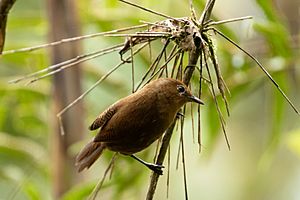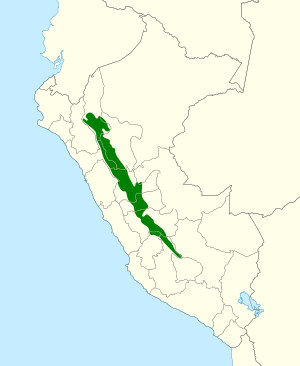Peruvian wren facts for kids
Quick facts for kids Peruvian wren |
|
|---|---|
 |
|
| Conservation status | |
| Scientific classification | |
| Genus: |
Cinnycerthia
|
| Species: |
peruana
|
 |
|
The Peruvian wren (Cinnycerthia peruana) is a small bird that belongs to the wren family. This special bird lives only in Peru, which means it is endemic to that country.
Contents
About the Peruvian Wren
Scientists study how different living things are related and how they get their names. The Peruvian wren used to be part of a group called the sepia-brown wren. But now, scientists have decided that the Peruvian wren is its own unique species. This means it is a "monotypic" species, having no subspecies.
What Does It Look Like?
The Peruvian wren is about 15.5 to 16 centimeters (about 6 inches) long. It weighs around 19.6 grams, which is about the same as a few quarters.
Its upper body is a rich chestnut color. Its head and lower back are a bit redder. It often has some white on its face, but this can be different for each bird. Its tail is also chestnut with thin black stripes.
The bird's chin and throat are an orange-brown color. Its chest, belly, and sides are a darker shade of the same color. Young Peruvian wrens probably look a lot like the adults, but they might not have the white on their faces.
Where Does It Live?
The Peruvian wren lives in the Andes mountains of Peru. You can find it in the areas between the Amazonas and Ayacucho departments.
It prefers to live in wet montane forests, which are forests found in mountains. It also lives in secondary forests (forests that have grown back after being cut down) and along the edges of these forests. These birds live at high elevations, from about 1,500 to 3,300 meters (about 4,900 to 10,800 feet) above sea level.
Behavior
Finding Food
Peruvian wrens often look for food in small groups. These groups seem to be made up of family members. They usually search for food on or near the ground, moving through plants and fallen leaves. Scientists are still learning exactly what they eat.
Reproduction and Life Cycle
The Peruvian wren seems to have a long breeding season. This means they might raise their young over several months. Scientists have seen nests with eggs, newly hatched chicks, and young birds learning to fly at different times of the year.
One nest that was found was shaped like a pouch. It had an entrance tunnel that pointed downwards. The nest was built using small roots, moss, and bamboo leaves. It was hanging from a bamboo stem.
Singing and Calls
Peruvian wren pairs often sing together. Their songs are described as "a magnificent series of rich trills and clear whistles." They also have a call that sounds like a "gravelly, chattering 'ch-d-d-d'." You can listen to their sounds online: song and call.
Conservation Status
The IUCN (International Union for Conservation of Nature) has looked at the Peruvian wren's population. They have listed it as "Least Concern." This means that, for now, the bird is not in immediate danger of disappearing.
However, even though it is quite common in some areas, its population is thought to be decreasing. This is mainly because its habitat (the place where it lives) is being destroyed or broken up into smaller pieces.
See also
 In Spanish: Cucarachero Peruano para niños
In Spanish: Cucarachero Peruano para niños


